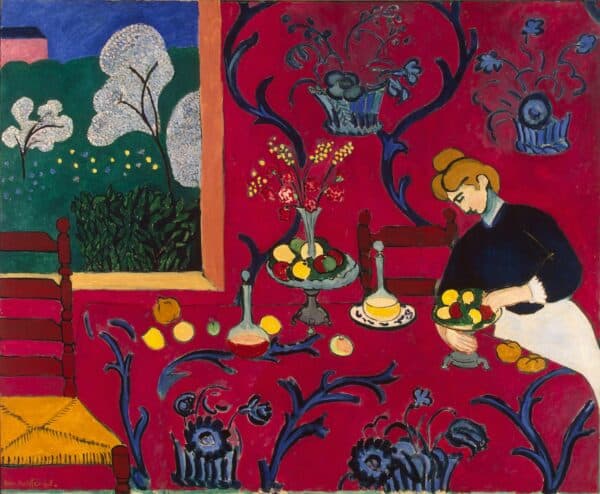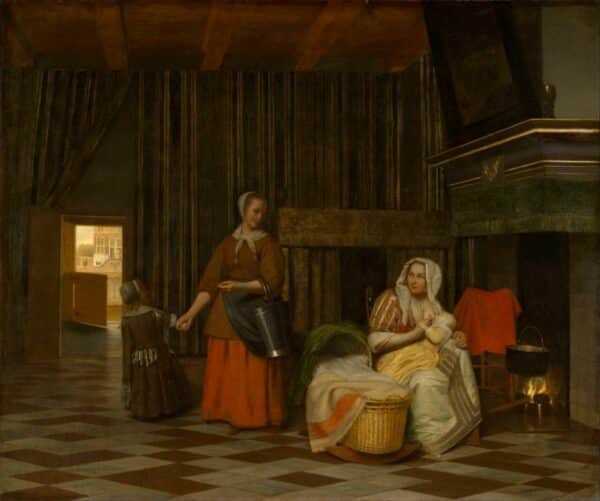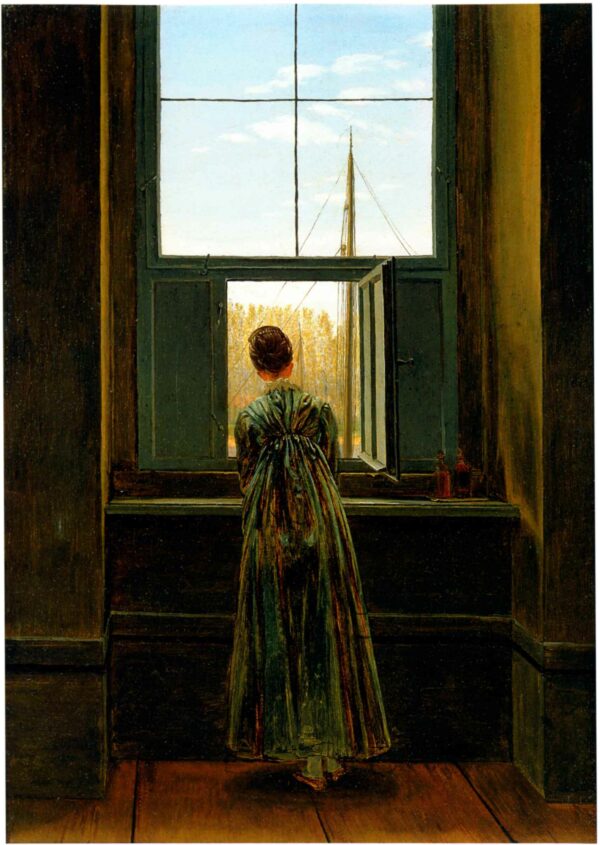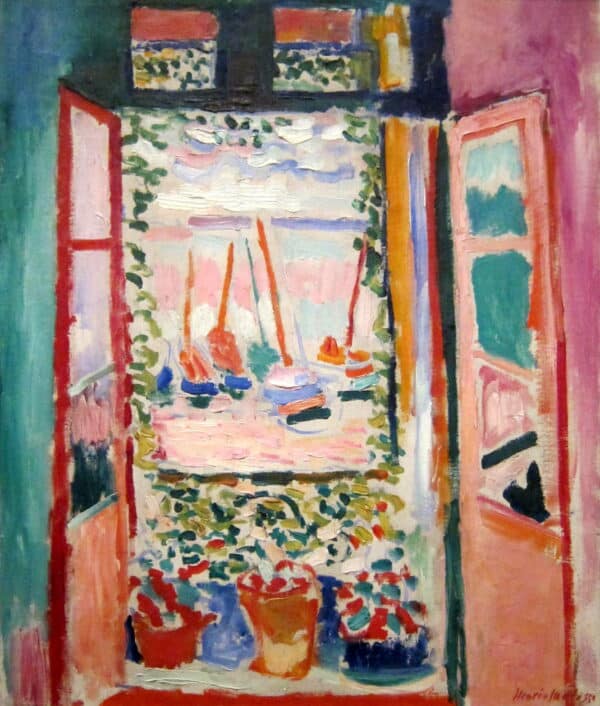Inside Looking Out in Art History

Henri Matisse, The Dessert: Harmony in Red (The Red Room), 1908, Oil on Canvas
As we make our way through March and towards the warmer months ahead, we find ourselves gazing out of the window towards the first inklings of spring. In celebration of this wonderful time of year, in which we transition from hunkering down and feeling cosy by the fire to spending more and more time outside, we thought we’d have a look into how that experience has been presented in paintings, through the recurring motifs of open windows and doorways.
Dutch Genre Painting and Woman and Child with Serving Maid by Pieter de Hooch

Henri Matisse, The Dessert: Harmony in Red (The Red Room), 1908, Oil on Canvas
For a subject matter that might mistakenly be considered mundane, artistic representations of windows, doorways and what lies beyond them are motifs which reoccur in an array of movements in art history. For example, Pieter de Hooch’s 1663-1665 work Woman and Child with Serving Maid is a wonderful encapsulation of the 17th century Dutch style of genre painting.
In this painting de Hooch presents a recognisable well to do household scene. An elegantly dressed mother nurses her baby, whilst her older child is cared for by a maid. Besides a few elements of brighter shades, a rich, earthy colour palette is used by de Hooch to imply understated sophistication. Furthermore, it allows for the emphasis of one of the most interesting parts of the composition.
Two quintessential themes of Dutch genre painting are the ways light and space are presented. In many golden age works, artists used natural lighting, often from windows and doorways leading outside, to gently illuminate meticulously formatted spaces. This work is no exception. De Hooch presents three spaces; the main room with its spotless checkered floor, a smaller dividing room and then, through a half open door, the canal and town houses of the street outside.
Whilst the warm flicker of the fire from the hearth implies the season may not yet be warm, the bright daylight that comes in through the door draws the viewer’s attention to the big wide world outside. Not only does the golden glow offset the darker interior, it also brings our attention to the composition’s narrative.
With a similar attitude of enchantment and curiosity as we have for the outside at the moment, the older child leans away from the maid and looks towards the open doorway. This highlights the painting’s biggest statement; the contrast between the matriarchal, well managed household space, compared to the more adventurous and spontaneous opportunities life brings once you venture outside.
Romanticism and Woman at aWindow by Caspar David Friedrich

Caspar David Friedrich, Woman at a Window, 1822, Oil on Canvas
Whilst Woman and Child with Serving Maid acts as a perfect example of a Dutch school genre scene, in Caspar David Friedrich’s wonderful oil painting Woman at a Window we are presented with a work that epitomises the concept of Romanticism.
In this work we see the figure of a woman looking out of a tall window that stretches beyond the top of the composition. The interior is made up of strong horizontals and verticals that depict a near empty room. The view, however, suggests the offer of adventure in the form of a boat’s mast, blue tinges of water and the green poplars that line the bank beyond.
As inWoman at a Window, Friedrich painted his figures with their backs to the viewer in many of his compositions. This allows the viewer to step into the subject’s shoes and experience the moment as if they are a part of the scene themselves. In this case the viewer assumes the role we find ourselves in more frequently at this time of year.
As the bare walls of the interior offer nothing but a stark living space, the window and landscape that is seen through it signify the Romantics enamourment with the natural world. Though the shades of green and brown in the woman’s dress echo the interior decoration, they seem to yearn to be amongst the trees. The wide, springtime sky calls to the human instinct to explore, discover and bask in nature’s glow.
Thus making Friedrich’s work an excellent reflection of our current sentiments.
Early Modern Icons and Open Window, Collioure by Henri Matisse

Henri Matisse, Open Window, Collioure, 1905, Oil on Canvas
Finally, for our last piece, we come to Henri Matisse’s Open Window, Collioure. Painted in 1905 and described as an ‘icon of early modernism’ by the National Gallery of Art, Open Window, Collioure is a prime demonstration of a recurring window motif found in many of Matisse’s works, as you can see in The Dessert: Harmony in Red (The Red Room), in the image above.
However, Open Window, Collioure doesn’t just exemplify Matisse’s individual oeuvre, it acts as an emblem of the avant-garde and the new direction in art to come.
Henri Matisse was one of the pioneers of the Fauvist movement; an early 20th century painting style which can be defined by the use of intense, often unnaturalistic colour palettes. In Open Window, Collioure Matisse’s use of blue, red and an array of pink captures both the viewer’s attention and the pulsating vibrancy of the outside world.
In a work where the painting technique is eclectic, the composition and perspective is also considered and complex. Described as “frames within frames”, Matisse’s use of short staccato brush strokes, as well as long and thoughtful mark making, helps to define the different spaces of the scene.
The blue-green walls almost appear to have a blurred effect. This creates a clear contrast between the calm of the inside and the frenzy of rapid strokes that make up the foliage of the balcony. Finally Matisse completes his view with steadier moments of pink, white and lavender. All of which coalesce to offer a sea and sky on which sail boats can playfully bob in and under.
Despite the Fauves being named so after the wild beasts critics associated their work with, Open Window, Collioure is also a work of great beauty which grasps the viewer’s mind and stimulates the senses. As we welcome springtime, we can feel a transition into new beginnings, excitement and growth. An essence of each Matisse captures beautifully in this wonderful window piece.
“My favourite journey is looking out of the window.”
– Edward Gorey, Writer, Illutrator, Poet & Costume Designer